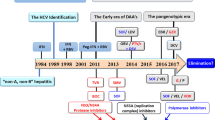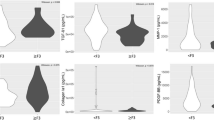Abstract
Inducible nitric oxide synthase (iNOS) is an important molecule involved in the host defense against infectious agents. iNOS is encoded by the NOS2A gene and well-defined haplotypes exist with respect to this gene. We examined whether these haplotypes were associated with the outcome of hepatitis C virus (HCV) infection in 619 Caucasian patients from seven European liver centres. We observed five major haplotypes: (−277A)+(−1026G)+(−1659C): haplotype 1; (−277G)+(−1026T)+(−1659C): haplotype 2; (−277G)+(−1026G)+(−1659C): haplotype 3; (−277G)+(−1026T)+(−1659T): haplotype 4; and (−277A)+(−1026T)+(−1659C): haplotype 5. Distributions of these haplotypes are comparable with those of previous studies. Homozygotes for haplotype 2 or those with haplotypes 2/4 were more likely than those with the 1/1 (wild type) combination to have self-limiting infections (odds ratios (OR)=3.43; 95% confidence intervals (95% CI): 1.10–8.0; P=0.0206 and OR=5.15; 95% CI: 1.32–14.32; P=0.0018, respectively). Conversely, carriage of haplotype 1 was associated with the lack of self-limiting disease (OR=0.48; 95% CI: 0.27–0.83; P=0.009). The effect was mainly among males (OR=0.41; 95% CI: 0.182–0.942; P=0.031 for males, and OR=0.55; 95% CI: 0.24–1.37; P=0.136 for women). Carriage of haplotype 1 was not associated with initial response (P=0.268) or sustained response (P>0.171). Combinations of haplotypes 1/4 were more likely to respond to interferon monotherapy in comparison of initial responders to nonresponders (OR=2.25; 95% CI: 1.05–5.68; P=0.0275).
This is a preview of subscription content, access via your institution
Access options
Subscribe to this journal
Receive 6 digital issues and online access to articles
$119.00 per year
only $19.83 per issue
Buy this article
- Purchase on Springer Link
- Instant access to full article PDF
Prices may be subject to local taxes which are calculated during checkout
Similar content being viewed by others
References
Burgner D, Rockett K, Kwiatkowski D . Nitric oxide and infectious diseases. Arch Dis Child 1999; 81: 185–188.
De Groote MA, Fang FC . NO inhibitions: antimicrobial properties of nitric oxide. Clin Infect Dis 1995; 21 (Suppl 2): S162–S165.
MacMicking JD, Nathan C, Hom G et al. Altered responses to bacterial infection and endotoxic shock in mice lacking inducible nitric oxide synthase. Cell 1995; 81: 641–650.
MacMicking JD, North RJ, LaCourse R, Mudgett JS, Shah SK, Nathan CF . Identification of nitric oxide synthase as a protective locus against tuberculosis. Proc Natl Acad Sci USA 1997; 94: 5243–5248.
Seguin MC, Klotz FW, Schneider I et al. Induction of nitric oxide synthase protects against malaria in mice exposed to irradiated Plasmodium berghei infected mosquitoes: involvement of interferon gamma and CD8+ T cells. J Exp Med 1994; 180: 353–358.
Wei XQ, Charles IG, Smith A et al. Altered immune responses in mice lacking inducible nitric oxide synthase. Nature 1995; 375: 408–411.
Burgner D, Usen S, Rockett K et al. Nucleotide and haplotypic diversity of the NOS2A promoter region and its relationship to cerebral malaria. Hum Genet 2003; 112: 379–386.
Burgner D, Rockett K, Ackerman H et al. Haplotypic relationship between SNP and microsatellite markers at the NOS2A locus in two populations. Genes Immun 2003; 4: 506–514.
DiBisceglie AM, Martin P, Kassianides C et al. Recombinant interferon alfa therapy for chronic hepatitis C. N Engl J Med 1989; 321: 1506–1510.
Davis GL, Balart LA, the Hepatitis Interventional Therapy Group et al. Treatment of chronic hepatitis C with recombinant interferon alpha. N Engl J Med 1989; 321: 1501–1506.
Poynard T, Marcellin P, Lee SS et al. Randomised trial of interferon alpha2b plus ribavirin for 48 weeks or for 24 weeks versus interferon alpha2b plus placebo for 48 weeks for treatment of chronic infection with hepatitis C virus. International Hepatitis Interventional Therapy Group (IHIT). Lancet 1998; 352: 1426–1432.
McHutchison JG, Gordon SC, Schiff ER et al. Interferon alfa-2b alone or in combination with ribavirin as initial treatment for chronic hepatitis C. Hepatitis Interventional Therapy Group. N Engl J Med 1998; 339: 1485–1492.
Manns MP, McHutchison JG, Gordon SC et al. Peginterferon alfa-2b plus ribavirin compared with interferon alfa-2b plus ribavirin for initial treatment of chronic hepatitis C: a randomised trial. Lancet 2001; 358: 958–965.
Zeuzem S, Feinman SV, Rasenack J et al. Peginterferon alfa-2a in patients with chronic hepatitis C. N Engl J Med 2000; 343: 1666–1672.
Kenny-Walsh E . Clinical outcomes after hepatitis C infection from contaminated anti-D immune globulin. Irish Hepatology Research Group. N Engl J Med 1999; 340: 1228–1233.
Wiese M, Berr F, Lafrenz M, Porst H, Oesen U . Low frequency of cirrhosis in a hepatitis C (genotype 1b) single-source outbreak in Germany: a 20-year multicenter study. Hepatology 2000; 32: 91–96.
Knapp S, Yee LJ, Frodsham AJ et al. Polymorphisms in interferon-induced genes and the outcome of hepatitis C virus infection: roles of MxA, OAS-1 and PKR. Genes Immun 2003; 4: 411–419.
de Vera ME, Shapiro RA, Nussler AK et al. Transcriptional regulation of human inducible nitric oxide synthase (NOS2) gene by cytokines: initial analysis of the human NOS2 promoter. Proc Natl Acad Sci USA 1996; 93: 1054–1059.
Annane D, Sanquer S, Sebille V et al. Compartmentalised inducible nitric-oxide synthase activity in septic shock. Lancet 2000; 355: 1143–1148.
Thursz M, Yallop R, Goldin R, Trepo C, Thomas HC . Influence of MHC class II genotype on outcome of infection with hepatitis C virus. Lancet 1999; 354: 2119–2124.
Germer S, Holland MJ, Higuchi R . High-throughput SNP allele-frequency determination in pooled DNA samples by kinetic PCR. Genome Res 2000; 10: 258–266.
Acknowledgements
The HENCORE group (Hepatitis C European Network for Cooperative Research) includes: Robert Goldin and Rhiannon Yallop (London, UK), Pierrre Pradat and Christian Trepo (Lyon, France), Juan Esteban (Barcelona, Spain), Stephanos Hadziyannis (Athens, Greece), Michael Manns and Hans Tillmann (Hannover, Germany), Alfredo Alberti and Liliana Chemello (Padova, Italy), Giorgio Saracco (Torino, Italy), Mario Rizzetto (Turin, Italy), and Jean-Henrik Braconier (Stockholm, Sweden). This work was supported by Roche Discovery, Welwyn, UK. Mark Wright was supported by the Medical Research Council. Angela Frodsham was supported by a Wellcome Trust Fellowship. Adrian VS Hill is a principal Wellcome Trust Fellow.
Author information
Authors and Affiliations
Rights and permissions
About this article
Cite this article
Yee, L., Knapp, S., Burgner, D. et al. Inducible nitric oxide synthase gene (NOS2A) haplotypes and the outcome of hepatitis C virus infection. Genes Immun 5, 183–187 (2004). https://doi.org/10.1038/sj.gene.6364054
Received:
Revised:
Accepted:
Published:
Issue Date:
DOI: https://doi.org/10.1038/sj.gene.6364054
Keywords
This article is cited by
-
Host and viral factors in the immunopathogenesis of primary hepatitis C virus infection
Immunology & Cell Biology (2007)
-
Inducible nitric oxide synthase (iNOS) expression in monocytes during acute Dengue Fever in patients and during in vitro infection
BMC Infectious Diseases (2005)
-
An investigation of NOS2A promoter polymorphisms in Australian multiple sclerosis patients
European Journal of Human Genetics (2005)



